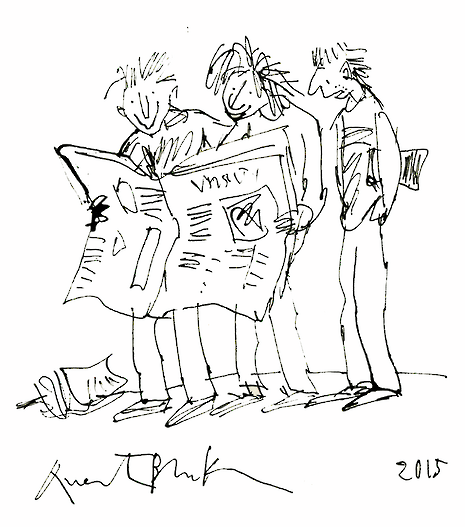The Interview: Quentin Blake
Ellie Olcott meets Sir Quentin Blake, Britain’s best-loved illustrator, to talk about his student years and working with Roald Dahl

In the proceeding few days before I had the good fortune to speak with Quentin Blake in his London studio, I was very aware of what a pervasive impact he has had on British culture. I spent one day in London and I saw people eating Ben’s Cookies, the logo of which Blake drew; I noticed a plethora of greetings cards and even bed sheets donning his work. Why does his work continue to be so popular? The answer is simple: it makes people happy. There is something irresistibly and relentlessly charming about his drawings and after spending over an hour in his company, I can say that this charm extends to his personality.
Blake welcomes me into his spacious flat where he works. The large windows that look over a typical London green square let light stream in and provide the perfect environment for his drawing. The studio is filled with hundreds of books that he has illustrated; a sign of his prolific career. Does the fact people still love his art encourage him to continue to work with such zeal? “I think I’d do it anyways!” he says with a gleeful smile, but acknowledges: “It helps”.
Blake has always been interested in literature, which he studied at Cambridge. He looks back fondly on his student years and with hindsight says it was the right decision not to go to art school straight away: “I thought, if I go to Cambridge, I will carry on drawing, but if I go to Art school, I might stop reading!” In the end, he did not spend that much time drawing while at Cambridge, wryly admitting: “I think I thought I ought to be more serious.” He led a fairly “quiet life” at Downing College: “I did a lot of reading”. Studying English “contributed” to his desire to become involved in the world of fiction. He spends a long time getting “a sense of the mood of the story”, typically reading the manuscript twice in order to make the illustrations “part of the interpretation”.
People associate Blake most closely with the novelist Roald Dahl, with whom he illustrated 18 books. Was Dahl very precise in his demands of Blake? “He wasn’t prescriptive, but I think he knew how to be if he wanted!” Blake says light-heartedly.
He describes the working relationship he had with Dahl: “First I would find the moments that would be good to illustrate, and then do a set of drawings of what I thought the characters looked like because you want to relate to the manuscript before you want to relate to the author in a way. And then I’d go to him and go through it all and get his comments”. Blake deliberates on his choice of words when he says “he could be quite a tough character… He was capable of falling out with people if he thought it would produce the right results!”
Evidence of this “very good” working relationship is manifest in the production of The BFG in 1982. This was the first long book Dahl and Blake worked on together and it was then that the “the collaboration really got under way”. Most children’s writers only commission a few illustrations in order to render the book more aesthetically pleasing. Dahl, however, broke convention by demanding more and more drawings from Blake.
Dahl originally described the BFG as “wearing an apron and boots”, something which he altered when he saw the materialisation of this in Blake’s drawings. The apron, according to Dahl, “got in the way”, “you don’t think about it when you’re writing it but he has to run across the mountains and jump up and down!” Blake knew the boots had to go when Dahl posted his own sandals to him, with a note saying “This is what the BFG would wear!” The illustrations Blake produced are integral to the reading of Dahl books. They have enabled generations of children to be exposed to the brilliant imagination of these two men.
Nowadays, Blake keeps himself very busy as he continues to work with authors, such as David Walliams on his recent novel, The Boy in the Dress. There are a few drawings scattered across his desk which he is currently working on. These are going to decorate the walls of a parent’s room at Great Ormond Street Hospital. Why do people ask him to do drawings for hospitals and care homes? “Generally I’m quite good at cheering people up!” He adds after some contemplation: “You can only be cheerful in the way you draw. You can’t be inappropriately cheerful and you have to keep a lot of things out of these pictures.”
He recently did some paintings for an eating disorder clinic in central London. This commission was particularly sensitive because “normally I like to draw in parallel worlds but here they [the patients] were already in a kind of parallel world which isn’t very good. So with those, I drew pictures of ordinary life wanting to convey that ‘it’s alright’.” He tried to incorporate food in subtle and inoffensive ways: a woman feeding birds, for example. Someone who had previously suffered from anorexia contacted Blake and told him that when “you look at them and you don’t feel criticised, you feel accepted”.
His work has always been done with the intention of making people happy. But has he ever considered engaging in the more satirical side of illustration and drawing political cartoons? “It’s not that I don’t have opinions. It’s just I can’t seem to work in that way. I never wanted to express opinions like that... I want to make fun of people but not to attack them.”
I think the reason people are so fond of his work is because it seems to evoke a feeling of freedom and joy in the observer. His work appears spontaneous and free. Does the drawing process reflect this? “If it goes over the line, it isn’t really by accident! It’s scratchy and looks like it hasn’t been finished, but really its exactly what I intend.
“I think the drawings appear spontaneous much in the same way someone acting on stage appears to be spontaneous, even though they have rehearsed it many times! People acting, speaking lines as if he just thought of them.”
Blake is kind enough to humour my audacious request that he draw something for Varsity. I watch as he conjures up a true Blake-esque drawing of some students reading this venerable newspaper. I can’t stop smiling as I hear the scratchings of his pen against the paper. “I’m not going to draw King’s College Chapel, you know!” he jokes.
I was afraid before conducting this interview that if I found Blake to be a person who had let his success take over his personality, it would somehow taint his drawings; drawings which let me hark back to a happy childhood.
Any feeling of nostalgia is well protected, however. I can say with all confidence that Blake is not only a brilliant artist, but also a thoroughly nice man.
 Interviews / You don’t need to peak at Cambridge, says Robin Harding31 December 2025
Interviews / You don’t need to peak at Cambridge, says Robin Harding31 December 2025 Comment / What happened to men at Cambridge?31 December 2025
Comment / What happened to men at Cambridge?31 December 2025 News / Unions protest handling of redundancies at Epidemiology Unit30 December 2025
News / Unions protest handling of redundancies at Epidemiology Unit30 December 2025 News / Varsity’s biggest stories of 202531 December 2025
News / Varsity’s biggest stories of 202531 December 2025 News / Downing investigates ‘mysterious’ underground burial vault 29 December 2025
News / Downing investigates ‘mysterious’ underground burial vault 29 December 2025









